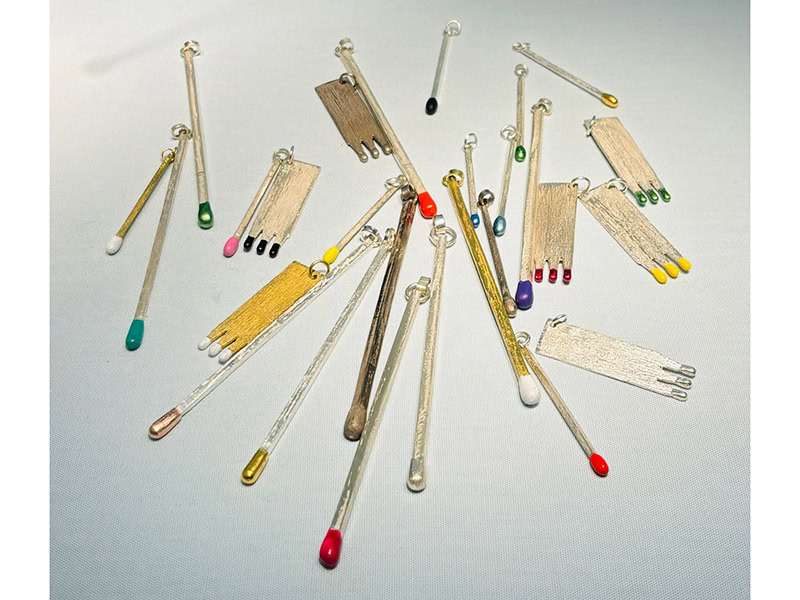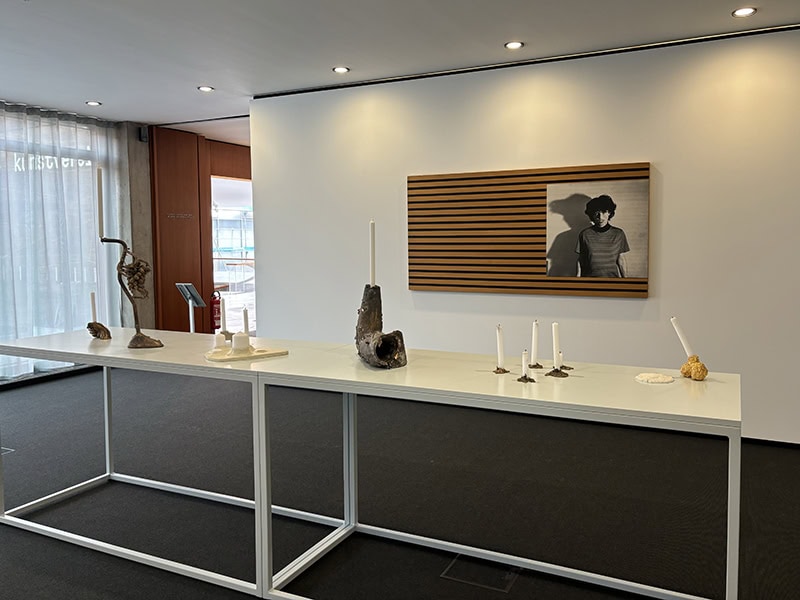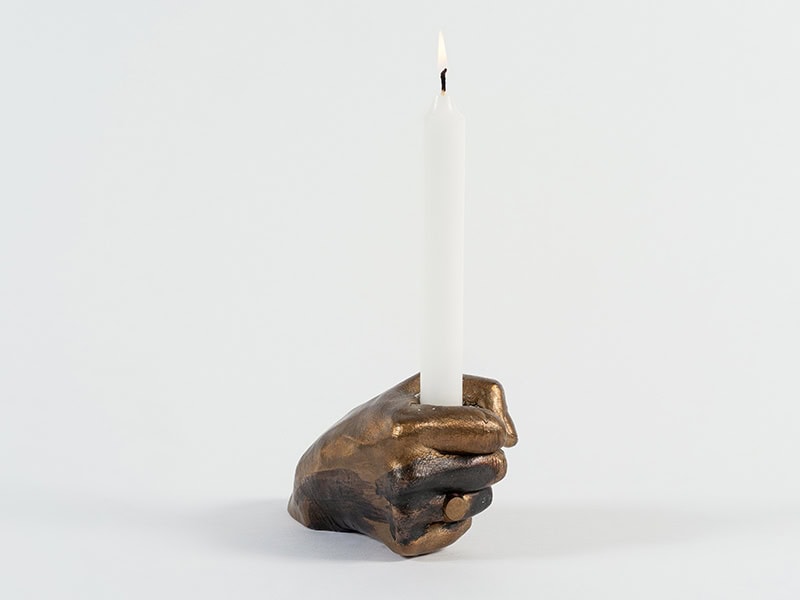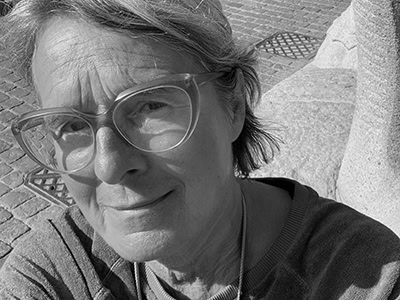Gabi Dziuba & Friends
February 25–May 26, 2024
Schmuckmuseum Pforzheim, Pforzheim, Germany

“SPLASH” shout the pendants and rings. “EGAL EGAL” (“whatever,” in English) clamor white gold and diamond rings in an effort to appease. “OH” screams a pair of red earrings, the letters dripping bloodily in the Rocky Horror Picture Show font. Blue beans and match pendants glow in vibrant enameled color, zirconia, and shining silver. Kermit laughs out loud on a white gold ring, his mouth studded with rubies, one eye a big white diamond, the other a black one. Square pendants yell “ZOMBIE BABY,” “ACCEPT,” “ICE,” “GAGA,” and more.
Words, letters, sayings, and comic figures are carried out in shining materials and with great skill. Welcome to the world of Gabi Dziuba & Friends, where haute couture and the underground, chic and trash, all meet in an uncomplicated and humorous way. In this world, authorship is not claimed or disputed but shared.
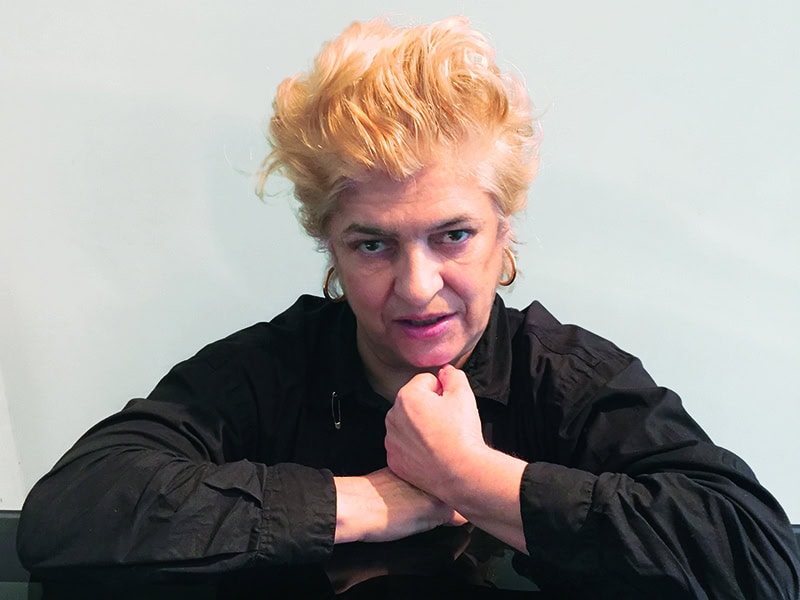
The friends of Gabi Dziuba (b. 1954) are well-known German visual artists of different generations. The exhibition at the Schmuckmuseum Pforzheim celebrates Dziuba’s unique years-long collaborations, together with an extensive overview of her own work since the 1970s.
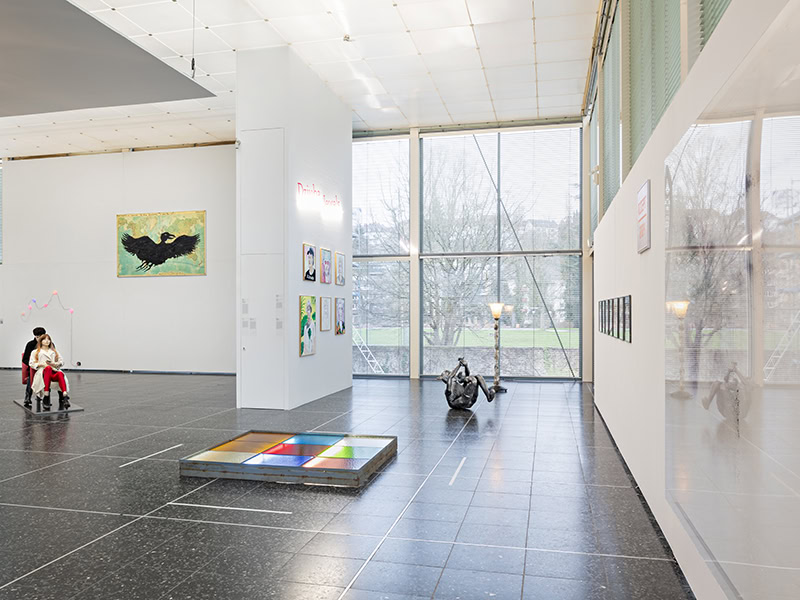
After studying in Pforzheim under Reinhold Reiling from 1972 to 1978, Dziuba continued her studies under Hermann Jünger at the Munich Academy of Fine Arts from 1978 to 1983. In Munich she met visual artists such as Günther Förg (1952–2013) and Hans-Jörg Mayer (b. 1955) with whom she has collaborated since. Through Förg and his artistic circle she met other artists, including the Austrian Heimo Zobernig (b. 1958). In 2006 he designed her beautiful though unreadable (thanks to the quirky layout) monograph, a book that her friends had regularly insisted she produce. When she settled in Berlin in 2009, she invited him to design her shop at Rosa-Luxemburg-Platz. Part of its interior, such as the large table display cases and the lamps of mirrored foil and synthetic Swarovski crystals, is now in Pforzheim’s jewelry museum, where it catches the eye in the spacious exhibition hall dedicated to the work of the artist friends. Installed close to the shop interior is a monumental monochrome white painting by Zobernig. When one approaches it, it lights up because of the reflections of tiny Swarovski stones.
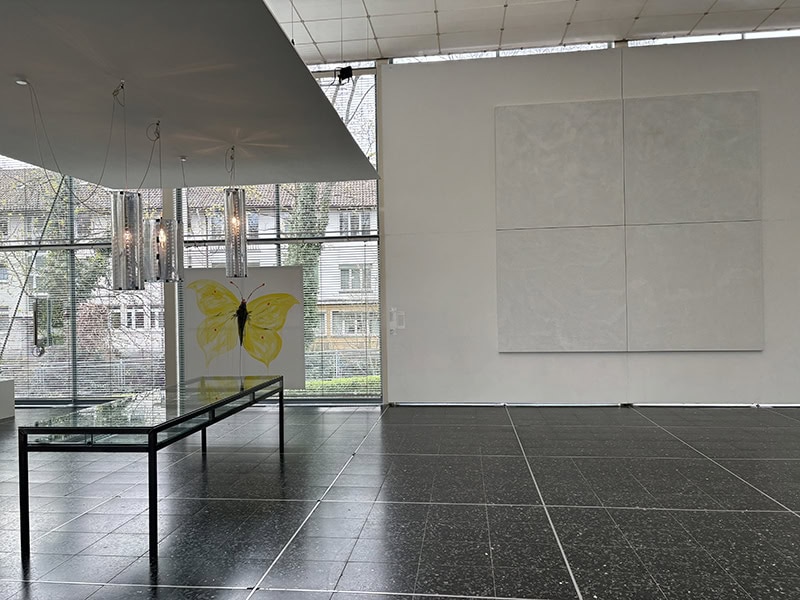
Thanks to Dziuba’s curiosity and direct attitude, collaborations develop with artists who are on the same wavelength: urban and experimental in their lives and art. The resulting jewelry explores reverberating ideas, transmitted in the goldsmith’s medium. Working together can happen just like that, for instance in a joint drawing session (Hans-Jörg Mayer and Manfred Bischoff). Or because someone—Martin Kippenberger (1953–1997)—wishes to receive a Dziuba-made St. Martin’s sword as a birthday present. But it can also start with a swap: Zobernig’s catalog design for a wedding ring (EGAL), which was then turned into an edition (EGALEGAL). Dziuba is not deterred by the craziest ideas. Neither are her friends. In this unique way Dziuba bridges the gap between Art and the so-called “minor” arts.
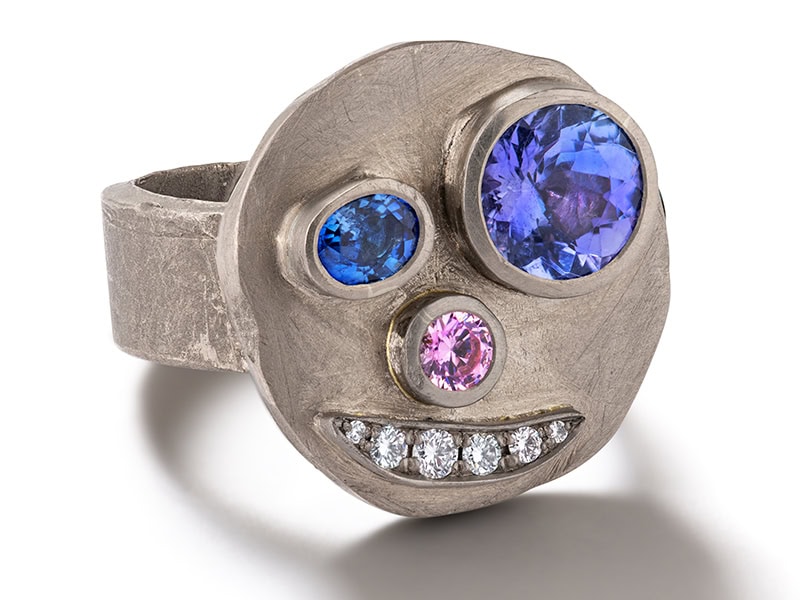
Her work is not loud or bursting with ego. Instead it is humorous, elegant, studded with diamonds or blingy zirconias, wearable, and as topical as can be. In 1992, she made a ring with a face, from yellow gold and leftover gems. Today, we would call it a “smiley.” But in 1992, before the development of the internet, hardly anybody in Europe knew about smileys besides young people involved in underground culture. In 2021, together with young artist Daniel Topka (b. 1992), they reissued the old idea using Gabi’s collection of “scrap” mismatched stones, which resulted in rings with titles like Werewolf, Ghost, and Zombie.
Over the years, banal things—pipes, matches, comic figures—pop up in her jewelry. Film and music are also sources of inspiration. She was the singer in a band with other artists in Munich, Die Schlüssel (The Keys, as a poke at The Doors). Song lyrics filter through in her jewelry as theme or as text fragment. Punk music was a revelation in the 1970s. A nice little sculpture of Ian Dury singing “Sweet Gene Vincent”—by her Pforzheim classmate Manfred Bischoff—a Blockhead logo on his T-shirt, and punky hair, recalls those days they spent in London.

Unlike Bischoff, Dziuba tends toward the sinister, dark, street, and bling bling side of culture. Her most recent collaboration, with visual artist Alexandra Bircken (b. 1967), in 2023, resulted in a collection of dangerous silver jewelry resembling razor wire (Natodraht in German). The cutting razor blades contrast sharply with the fragility of the body and the flesh. They make you shiver and create a feeling of despair when thinking of razor wire coils to keep unwanted people out or in. These pieces are not wearable, a concession to Bircken. Dizuba doesn’t like one-way traffic, the route most jewelry artists take. She gets carried away on the unpredictable waves of exchange.
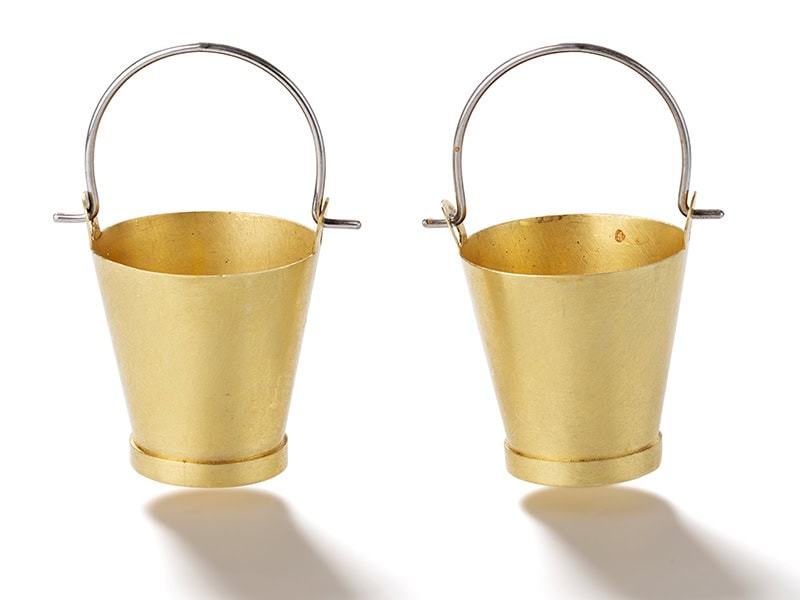
Already as a student in Pforzheim her work was humorous and well made, with a tendency toward luxurious materials. There is a lot to discover in showcases filled with jewelry she made as a student. Two pairs of earpieces from her Pforzheim years are meant to wear over your ears, like ear extensions or ear caps. The inventive golden bucket earrings left a lasting impression on many colleagues, and inspired photographers. At the academy in Munich, she experimented with materials, designs, and new ways of decorating the body. She designed brooches consisting of three to 18 identical shapes, such as 18 gilt copper sticks, that should be worn together—how would that look? Great idea, to have the Polaroids of people who volunteered for this 1980s experiment in body adornment.
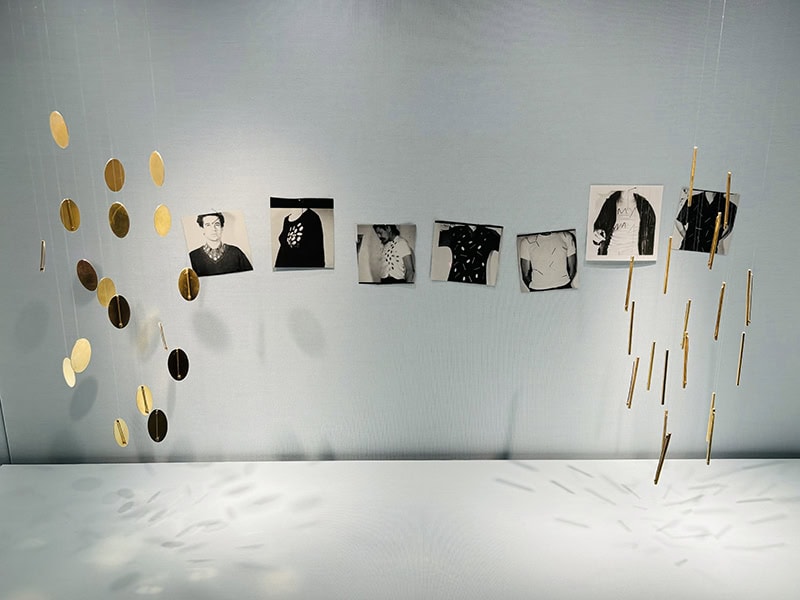
The exhibition comprises different spaces in the museum. Normally the jewelry gallery with showcases and sliding drawings for additional information is used for temporary exhibitions. This exhibition uses almost the entire museum: besides the jewelry gallery, it’s in the large exhibition hall, while the so-called “making-of jewelry room” displays small sculptures (candlesticks from different artists and heads by Günther Förg), and a photo wall is installed in the room of the permanent contemporary collection. These photographs from fashion and art photographers inspired by Dziuba’s work are a fine addition to the exhibition.
When I visited the exhibition, the catalog was not ready, but I got a sneak preview. The book is a good reflection and lasting documentation, including photos of the exhibition. The texts by museum director Cornelie Holzach and exhibition curators Vera Gliem and Stephan Strsembski, covering the different periods in Dziuba’s life, are supplemented by an interview with the artist, and texts from friends and others. All are informative, readable, and inviting. The graphic design that by turns looks like a scrap book and then again like a catalog, the abundance of documentary material and good photography, alternating with various texts, hits a nerve. Capturing the phenomenon of Gabi Dziuba is quite an undertaking, but the Schmuckmuseum succeeded very well.
This exhibition was curated by Vera Gliem, Elisabeth Heine. and Stephan Strsembsk. The “& Friends” artists included in the exhibition are Monika Baer, Dirk Bell, Alexandra Bircken, Manfred Bischoff, Günther Förg, Karl Fritsch, Thilo Heinzmann, Axel Hütte, Andy Hope 1930, Teresa Iten, Martin Kippenberger, Kalin Lindena, Hans-Jörg Mayer, Christian Philipp Müller, Markus Oehlen, Tobias Rehberger, Henning Strassburger, Jan Timme, Daniel Topka, Marcus Weber, Joseph Zehrer, and Heimo Zobernig. It is accompanied by a flyer and a catalog. Visit Schmuckmuseum Pforzheim’s exhibition page here.
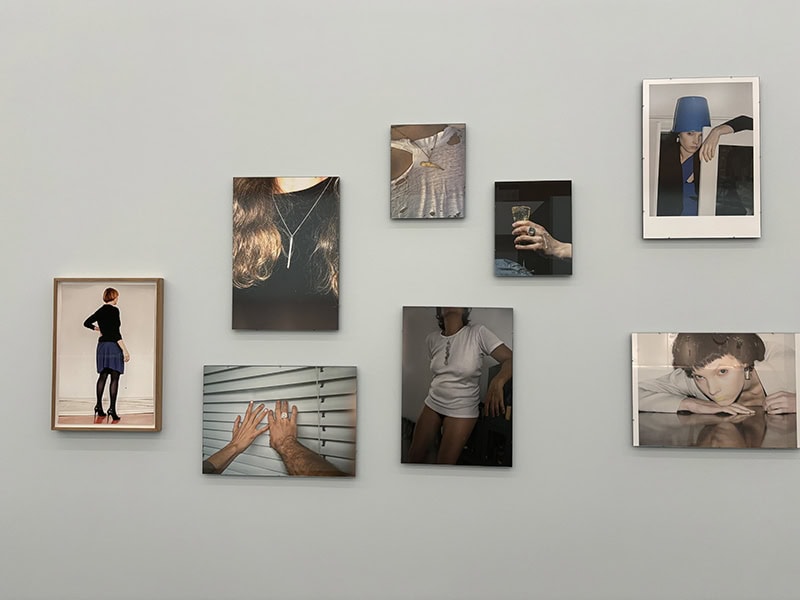
GABI DZIUBA & FRIENDS (GABI DZIUBA Y AMIGOS)
Autoría compartida, portabilidad y lo que sea…
Texto original de Liesbeth den Besten, traducido por Jimena Rios
Gabi Dziuba & Friends
Febrero 25–Mayo 26, 2024
Schmuckmuseum Pforzheim, Pforzheim, Alemania

“SPLASH” gritan los pendientes y anillos. “EGAL EGAL” (“da igual” en español) claman anillos de oro blanco y diamantes en un intento de tranquilizar. “OH”, escrito en la tipografía que chorrea sangre de Rocky Horror Picture Show, gritan un par de pendientes rojos. Alubias azules y pendientes a juego brillan en un vibrante color esmaltado, zirconitas y plata pulida. Kermit ríe a carcajadas en un anillo de oro blanco, su boca esta llena de rubies engastados, un diamante blanco grande en un ojo y uno negro en otro. Pendientes cuadrados también gritan “ZOMBIE BABY,” “ACCEPT,” “ICE,” “GAGA,” entre otras cosas.
Palabras, letras, frases y personajes hechas en materiales brillantes y con gran destreza técnica. Bienvenidos al mundo de Gabi Dziuba & Friends, donde la alta costura, lo contracultural y la mezcla entre la sofisticación y lo vulgar conviven de una manera simple y con mucho sentido del humor. En este mundo la autoría no se reivindica ni entra en disputa, se comparte.

Los amigos de Gabi Dziuba (1954-) son artistas alemanes reconocidos de distintas generaciones. La exposición en el Schmuckmuseum de Pforzheim celebra las excepcionales colaboraciones de Dziuba a lo largo de los años junto a un recorrido por su obra desde 1970.

Después de estudiar en Pforzheim, entre 1972 y 1978, con el maestro Reinhold Reiling, Dziuba continuó su formación, desde 1978 hasta 1983, en la Academia de Munich con Hermann Jünger,. En esa ciudad conoció a los artistas visuales Günther Förg (1952–2013) y Hans-Jörg Mayer (b. 1955) con los que colaboró desde ese entonces. A través de Förg conoce a otros miembros de su círculo artístico incluyendo al austríaco Heimo Zobernig (b. 1958). En 2006 él diseñó para ella un precioso aunque ilegible (gracias al diseño gráfico) libro monográfico que sus amigos insistieron en que hiciera. En 2009 cuando Dziuba se mudó a Berlín, lo invitó a que diseñara su tienda en la Plaza Rosa Luxemburgo. Parte de ese interiorismo, como las grandes vitrinas de mesa, las lámparas de papel espejado y cristales Swarovski se puede ver en el museo de joyería de Pforzheim donde llaman la atención en la gran sala dedicada a las obras de los amigos de la artista. Muy cerca del mobiliario del interior de la tienda está instalada una pintura monocromática de gran escala de Zobernig. Cuando uno se acerca se ilumina por el reflejo de pequeños cristales Swarovski.

Gracias a la curiosidad de Dziuba y a su manera de ser frontal, surgen colaboraciones con artistas con los que comparte una forma urbana y experimental de ver la vida y el arte. Las joyas que resultan de estos encuentros tienen idea que resuenan cuando son transmitidas en el lenguaje de la joyería. Las colecciones surgían de manera muy espontánea, por ejemplo en una sesión de dibujo compartida (Hans-Jörg Mayer y Manfred Bischoff). O porque alguien, Martin Kippenberger (1953–1997), quería como regalo de cumpleaños una espada de St. Martin hecha por Dziuba. Pero también podría empezar con un intercambio: Zobernig diseñaba el catálogo de la artista a cambio de un anillo de boda (EGAL), después terminó siendo una edición (EGALEGAL). A Dziuba no le intimidaba ninguna idea por más loca que fuera, a sus amigos tampoco. De esta manera Dziuba tiende un puente entre las artes visuales y las llamadas “artes menores”.

El trabajo de Dziuba no es estridente ni está cargado de ego. Por el contrario tiene mucho sentido del humor, es elegante, tiene diamantes engarzados o zirconitas brillantes, es portable y siempre mantiene la mayor actualidad posible. En 1992, hizo un anillo de oro amarillo y piedras con una cara. Hoy lo llamaríamos “smiley.” Pero en ese año previo al desarrollo de internet, casi nadie en Europa sabía lo que era un smiley excepto la gente joven que se movía en el ámbito de la contracultura. En el año 2021, junto con el joven artista Daniel Topka (b. 1992), retomaron esa vieja idea usando esta vez las piedras sueltas que Gabi había descartado, el resultado fue una serie de anillos con títulos como “Werewolf” (Hombre lobo), “Ghost “(Fantasma) y “Zombie.”
A lo largo de los años cosas banales, tuberías, fósforos, personajes, aparecen en sus joyas. El cine y la música también fueron fuentes de inspiración. Gabi Dziuba fue cantante de una banda que formó con otros artistas de Munich, se llamaba “Die Schlüssel” (La llave en alemán, haciendo un guiño a The Doors). Las letras de las canciones se filtraban en sus joyas como tema o en fragmentos. La música punk fue una revelación en los años 70. Una pequeña escultura de Ian Dury cantando “Sweet Gene Vincent”, hecha por su compañero de clase en Pforzheim, Manfred Bischoff, el logo de Blockhead en su camiseta y un peinado punk, dan testimonio de los días que pasaron en Londres.

A diferencia de Bischoff, Dziuba elige el lado más siniestro, oscuro, urbano y excesivo de la cultura. Su colaboración más reciente, en 2023, con la artista Alexandra Bircken dió como resultado una colección de joyas peligrosas en plata que se asemejan a alambres de púa (Natodraht en alemán). Las cuchillas filosas contrastaba con la fragilidad del cuerpo y la piel. Las cuchillas te hacen estremecer y provocan una sensación de desesperación cuando piensas que mantienen afuera o adentro a determinadas personas. Estas piezas no son portables, una concesión que le hace a Bircken. Dizuba nunca toma un solo camino, como hacen la mayoría de los artistas. Ella se deja llevar por las olas impredecibles que traen estos intercambios.

Ya en su etapa de estudiante en Pforzheim su trabajo tenía mucho sentido del humor, estaba bien hecho y Dziuba tenía la tendencia de usar materiales lujosos. Hay mucho para descubrir en vitrinas llenas de joyas hechas en su época de estudiante. Dos pares de pendientes de sus años de Pforzheim estaban hechos para ser usados sobre las orejas, como extensiones o copas. Los ingeniosos cubos de oro dejaron una marca imborrable en muchos de sus colegas e inspiraron a muchos fotógrafos. En la academia de Munich, experimentó con materiales, diseños y maneras novedosas de adornar el cuerpo. Diseñó una serie de broches que consistían en formas idénticas que iban en grupos de 3 a 18, una de estas series estaba formada por 18 alambres de cobre bañados en oro que deberían ser usados juntos. ¿Cómo quedarían puestos? Una gran idea en la exposición fue mostrar las polaroids de los voluntarios que en 1980 pusieron estas piezas.

La exposición toma casi todo el espacio del museo. En la sala que normalmente es usada para exposiciones temporales encontramos la galería con vitrinas y los gráficos con información adicional. Esta exposición ocupa casi todo el lugar: aparte de la galería para joyas, las piezas se encuentran también en la gran sala para exposiciones y, en el llamado “cuarto para hacer joyería”, se pueden ver pequeñas esculturas (candelabros de diferentes artistas y cabezas hechas por Günther Förg).
En la sala de la colección permanente de joyería contemporánea se instaló una pared con fotos. Estas imágenes van desde fotos de moda y arte inspirados en el trabajo de Dziuba son una excelente adición a la exposición.
Cuando visité la exposición el catálogo aún no estaba disponible pero pude ver un avance. El libro es un reflejo del trabajo de Dziuba y un buen material de documentación, incluye fotos de la exposición. A los textos de la directora del museo Cornelie Holzach, que analizan los diferentes periodos de la vida de Dziuba se le suma para completar una entrevista a la artista, textos de amigos y otros. Todos son informativos, de fácil lectura y una invitación a conocer a la protagonista. El diseño gráfico va y viene entre un libreta de recortes y un catálogo, la abundancia de material documental y la calidad de la fotografía alternadas con los buenos textos logran un libro que conmueve. Registrar el fenómeno Gabi Dziuba es todo un desafío que Schmuckmuseum logró con éxito.
Esta exposición fue comisariada por Vera Gliem, Elisabeth Heine. and Stephan Strsembsk. Los artistas de “& Friends” incluidos en la exposición son Monika Baer, Dirk Bell, Alexandra Bircken, Manfred Bischoff, Günther Förg, Karl Fritsch, Thilo Heinzmann, Axel Hütte, Andy Hope 1930, Teresa Iten, Martin Kippenberger, Kalin Lindena, Hans-Jörg Mayer, Christian Philipp Müller, Markus Oehlen, Tobias Rehberger, Henning Strassburger, Jan Timme, Daniel Topka, Marcus Weber, Joseph Zehrer, and Heimo Zobernig.

Reviews are the opinions of the authors alone, and do not necessarily express those of AJF.
We welcome your comments on our publishing, and will publish letters that engage with our articles in a thoughtful and polite manner. Please submit letters to the editor electronically; do so here.
© 2024 Art Jewelry Forum. All rights reserved. Content may not be reproduced in whole or in part without permission. For reprint permission, contact info (at) artjewelryforum (dot) org

